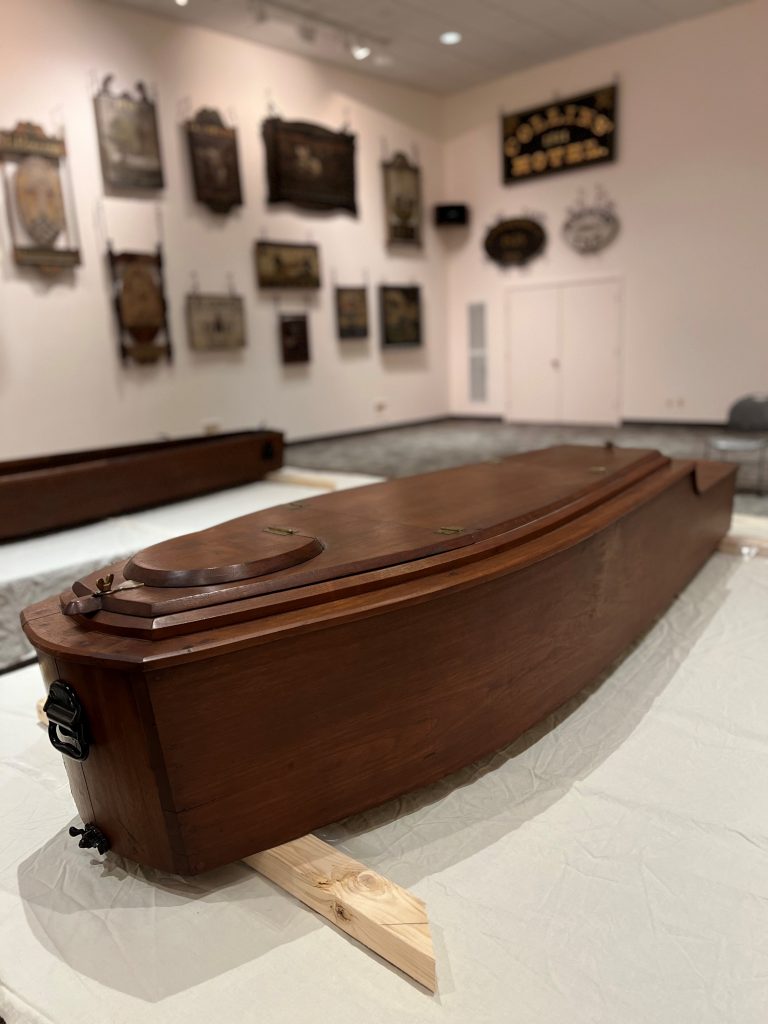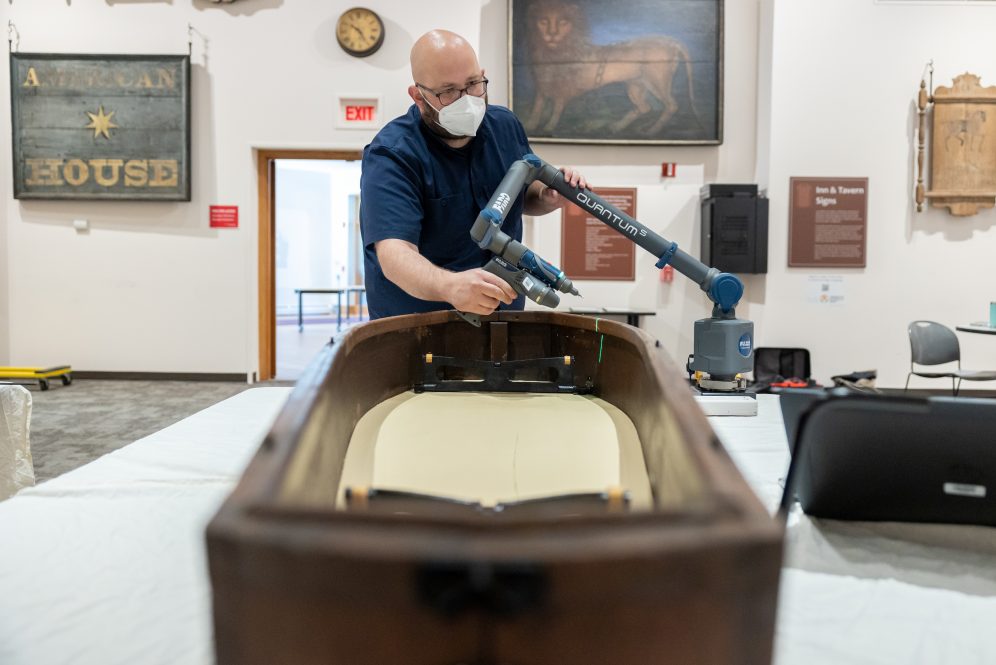In the days before modern embalming, there was ice.
And a corpse preserver – a hardwood box large enough to hold the remains of the recently deceased.
Once placed in a lower chamber, a dead body would be nestled below a thick layer of ice, meant to slow the decomposition process while allowing mourners to view the face of their deceased loved one, albeit through a small window and a pane of glass.
Water from the melting ice drained through two ports at the preserver’s foot-end, continuously emptying into awaiting buckets and indicating when more ice was needed to keep the interior cool. The corpse was laid out on a board and would rest on iron supports, and an exterior crank allowed for the head or feet to be lifted or lowered within the box for better viewing from the outside.
The Connecticut Historical Society is home to a corpse preserver from the late 1870s – constructed of walnut, iron, horsehair insulation, and glass. Preservers like this were used in the late 1800s by local morticians. The devices saw a particular rise in popularity with an influx of Catholic immigrants during the time period.
“When a lot of Catholic immigrants started coming to Connecticut, and they brought with them the practice of having wakes, they needed something to be able to preserve and display the body,” explains Andrea Rapacz, the Connecticut Historical Society’s director of collections.

While the historical society’s collection includes more than 265,000 artifacts and images from the state’s history, the antique corpse preserver stands out for both its uniqueness – few of them remain intact in collections around the country – and its eeriness.
“It’s absolutely one of our creepiest things,” Rapacz says. “We do have other creepy things, like jewelry made out of hair and things like that. But this is high up on the list.”
And just in time for spooky season, members of the public will have a chance to see and experience this macabre antique innovation in whole new way on Thursday, October 20 through a unique technological partnership with the Connecticut Historical Society, the Connecticut Tech Council, and UConn.
Modeling History
Joseph Luciani is the director of the Proof of Concept Center at the Innovation Partnership Building (IPB) at UConn Tech Park. He’s worked at the University for six years, and primarily runs a prototyping lab that collaborates with small businesses.
“My lab is primarily focused on small or medium-sized manufacturers and helping them with technology jumps,” says Luciani. “The space that I run is a prototyping lab, so it’s filled with 3D printers and machining centers – machines that help us make products. Most people think of a prototyping lab as where I can go to take my next big idea. But really what we’re doing is we’re focusing on the tools that help people make those ideas.”
This October, he brought one of the modern technological tools of his trade – photogrammetry – to the Connecticut Historical Society’s Library and Museum in Hartford to help build an interactive virtual model of the society’s antique corpse preserver.
Luciani took a large series of highly detailed and high-resolution photographs of the corpse preserver’s visible surfaces. Once completing that process, Luciani then used photogrammetry – a coordinate measuring technique – to extract three-dimensional information from the two-dimensional photographs in order to create a permanent, highly detailed digital representation of the six-foot-long corpse preserver.
“If I modeled this from scratch, just built a 3D model, it’d be perfect,” he explains. “You wouldn’t have any of the history or even the imperfections of having a woodworker build it – it’s hard to replicate the crafted hand of a woodworker, or where this is black-smithed together. It’s artisanal, more so than just manufactured.”
On October 20, the historical society, UConn IPB, and the Connecticut Tech Council will host “X-Ray Vision: A Look into the Past” at the historical society’s museum and library on Elizabeth Street in Hartford, a family friendly event where the public can view and interact with the new digital model – as well as the original corpse preserver – and learn more about how modern science and technology are helping historians and researchers learn more about the past.

“CT Tech Council is a networking hub for technology companies in Connecticut – we strive to make technology accessible for all ages, and this family-friendly event does just that,” says Simon Lichter, the tech council’s executive director. “We have partnered with UConn and Connecticut Historical Society to offer this innovative and fun event around the holiday of Halloween. During the evening of Thursday, October 20, attendees can expect to be amazed how high-tech research equipment can be used on historical objects and how these observation techniques are bringing history closer to study and learn from.”
An Innovative Partnership
While the partnership with the historical society led to Luciani’s first-ever interaction with a creepy piece of funerary history, the organization and UConn IPB plan to continue using advanced technologies to discover hidden secrets while helping to preserve some of the collection’s artifacts.
“UConn’s Innovation Partnership Building has a wealth of incredible equipment available for use by Connecticut businesses,” says Michael DiDonato, the IPB’s business development manager. “We were eager to connect with the Connecticut Historical Society to highlight the stark contrast of new high-tech equipment at the IPB with historic antiquities from our state’s history, all in the effort to spread the word of our facility’s capabilities.”
It’s a partnership that benefits both groups – with IPB researchers using their technological skills in new and creative ways while helping the historical society create lasting digital representations of priceless pieces of Connecticut history.
“We usually try to not touch the objects too much,” explains Rapacz. “Being able to get scans like this, to be able to see something from all directions, it’s really great for us. We might see something that we’ve never seen before and be able to look at it from a different perspective.”
“The partnership is fun!” DiDonato says. “Our researchers get excited about the possibility of using advanced scanning and microscopy equipment to explore our past, and we’re secretly hoping to discover something historically relevant – but we’ll see. Our investigation of the corpse preserver is the first of hopefully many interactions as we show off Connecticut’s available resources at the IPB to help research Connecticut’s past.”
For more information or to RSVP for the October 20 event “X-Ray Vision: A Look into the Past,” visit www.ct.org/events.
For more information about the technology offerings and business and nonprofit partnership opportunities available through the UConn IPB and UConn Tech Park, visit techpark.uconn.edu.



